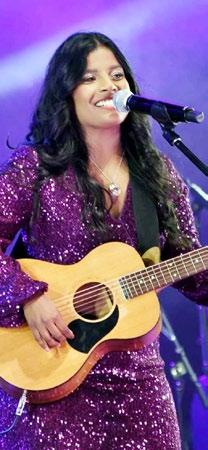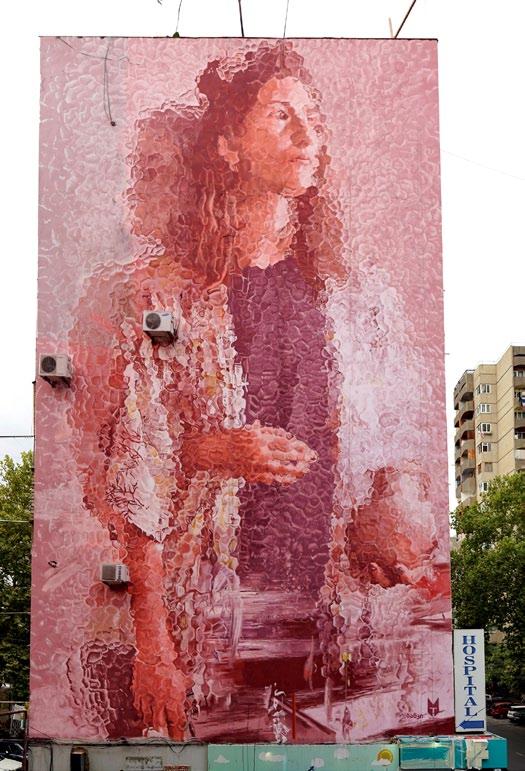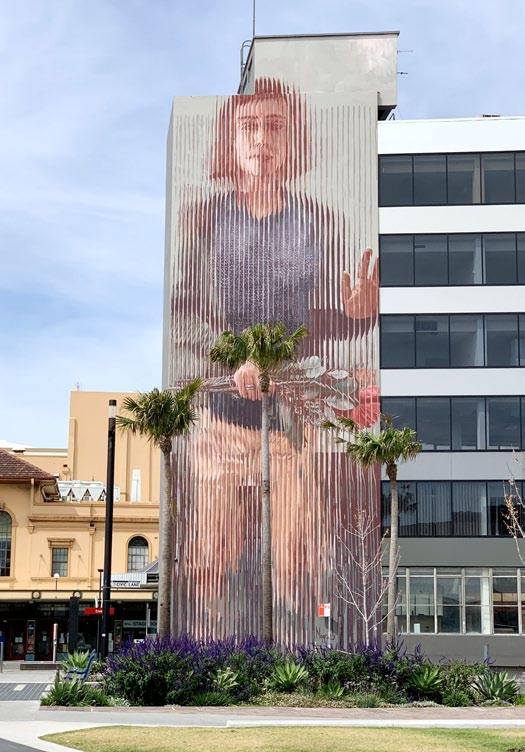
6 minute read
There’s room for diversity in Australian country music
from 2023-04-Melbourne
by Indian Link
Challenging Expectations Of What A Country Singer Looks Like
breaking stereotypes and making waves in the Australian country music scene.
By K EONIA SWIf T
Take me back to when we were just 17 We ruled the world, we knew who we were gonna be And then life came along and killed our teenage dream inger-songwriter Kiara Rodrigues claims she wrote her charting High School Reunion as she took stock of her life in pandemiccaused isolation, wondering what a high school reunion would look like for her, ten
She can rest assured, however, that her own teenage dreams are well and truly
As a first-gen Indian-Australian, she is
Singing since she was nine years old, Kiara has won several awards, including “Female Rising Star” at Southern Stars Australian Independent Country Music Awards; the Tamworth Songwriter’s Association Comedy Song of the Year (for her song Mr. Vanity), and Triple World Champion (Country, Gospel, Rock) at the ‘World Championships of Performing Arts’ in Hollywood.
She has also made her mark on the charts, with three singles debuting in the top five of the Australian Country iTunes Charts; has sung at the world-renowned Tootsies in Nashville, and performed the national anthem at NRL games.
“People often wonder how someone with an Indian background gets into country music,” Kiara tells Indian Link. “The stereotype is often blonde hair, cowboy boots and cowgirl dress! But my parents grew up on all these songs that they didn’t necessarily know were country. As a result, I’ve ended up listening to those songs and having that influence in what I do now.”
Kiara’s parents migrated to Australia in 1994 from Mumbai, arriving in Melbourne and then moving to North Queensland. Today the 27-year-old is based in Sydney, and works as a speech pathologist when she’s not singing.
Influenced by country music, the stage beckoned from a young age, with appearances on Channel Ten’s Young Talent Time and X Factor.
Classic country artists such as Patsy Cline, Willie Nelson, and Dolly Parton heavily influence Kiara’s music. She is also inspired by more contemporary country artists such as Kacey Musgraves and Ashley McBryde.


“What all of those artists have in common is their ability to tell stories,” Kiara muses. It’s no surprise to see this reflected in her own work. She writes in High School Reunion:
Shelly’s on her second husband Betty’s on her second kid, and Mary’s on her second shot a whiskey just to get through this
Or again, in her latest single Message in a Bottle
Gonna drink you right out of my mind When the bottle’s empty I feel empty too Her songwriting just as accomplished as her vocal prowess, Rodrigues hopes listeners will take away the stories behind her music and relate to them.
“The stories are often my own experiences, or the experiences of other people around me. My hope is that listeners can find something that they relate to. Being able to relate to others through your work is what it’s all about.”
Explaining her creative process, Kiara reveals, “I start with an idea and then put a unique spin on it, often finding inspiration between my laptop, piano, and guitar.”
She’s currently writing new music for an EP to be released shortly.
As a person of colour in Australia, Kiara Rodrigues acknowledges that she has faced challenges and barriers in the country’s music industry. “You’re often striving against Western beauty standards of what a singer looks like, what a popstar looks like, and what a country singer looks like. And I think it’s really great to have that opportunity to be able to change and challenge those expectations of what a country singer in Australia looks like.”
Despite the challenges, Kiara Rodrigues sees her role as an opportunity to inspire younger children who look like her to pursue their dreams. “Growing up, I didn’t really have that in Australian country music, but things have now gotten a lot more diverse. So to be able to be that representation for our Indian community in the country music industry and in the wider industry as well, it’s just a real privilege.”
Kiara Rodrigues’ rise to prominence demonstrates that there is room for diversity and different perspectives in country music.
Beginning now to see a country music industry that is welcoming and which values diversity, she advises aspiring country singers to “just jump right in.”
“As a person of colour, no matter what community you are from, being as visible as you can be, and getting out there, is the best thing you can do. Be seen, and add to the diversity. So my best advice would be, be proud of your heritage, and just do it!”
By PRUTHA CHAKRABORTY
If you ever cross the Dadar suburbs of Mumbai city, a massive mural painted across outer walls of four tall buildings will put some pep in your step. The artwork features two hands holding flowers – an ode to the vendors in the area who are witness to the changing urban landscape of this fast-paced city.
Deserving full credit for this project, is Australian street artist Fintan Magee. It took him five whole weeks, two assistants and a strong will to battle Mumbai’s scorching heat to complete this mural.


The Brisbane-based artist spent a considerable amount of time in Dadar’s market – where flowers are fresh heaped, fragrant and colourful.
“The Mumbai project was definitely difficult,” Magee tells Indian Link. “The walls were big and there were too many windows. The image had to be split up as I had to paint one theme across four buildings. Good thing is such projects help me branch out, get out of my comfort zone and give me an opportunity to make something new!”
This isn’t Magee’s first painting in India –in 2019, he created a mural in Goa featuring three local workers holding the base of a Roman column.
Magee is celebrated world-over for his socially and environmentally engaged works. He uses large-scale murals to depict intimate moments and communicate political and social viewpoints.

His Dadar mural comes at a critical time when Mumbai-based activists are at loggerheads with the state government over a Metro car-shed construction that will wipe off a portion of the luscious and vast Aarey Colony – also dubbed the ‘green lung’ of the city.
When asked if his mural is hinting at that, Magee says: “My mural is a statement on the dignity of hardwork and the beauty of craftmanship. It also portrays the fragility of nature in a developed city like Mumbai.”
But he adds that he loves our interpretation. “I wasn’t aware of the fight the activists are having with the authorities here. In hindsight, Mumbai does need a Metro to decongest the city. But I did notice this on my trip here that the city doesn’t have any green space either. There is definitely a need to treasure the green space.”
Magee says he is glad his work in the public eye can make people think and form different perspectives. “Art takes a life of its own sometimes,” he smiles.
Magee has been painting professionally for close to 10 years now. He doesn’t shy away from crediting his creative parents –architect mum and sculptor dad – for this. “I’ve been drawing from a young age; it was always there in me,” he says. “Growing up, dad had a studio so naturally there was material around to experiment with. I think it is important when you are young.”
What about other influences?
“There were always lots of books around. My dad had a big book on English painter David Hockney (who had a major contribution in the pop art movement of the 1960s). I grew fond of his works. And also, there was Australian cartoonist Michael Leunig.”
Magee was also obsessed with drawing planes and dreamt of becoming a pilot. But his colour blindness came in the way. “When I realised I couldn’t become a pilot, I became an artist, which I realised is the second-worst job to have if you are colour blind,” he laughs.
But that doesn’t surprise us. After all, mant great artists are colour blind, including Frenchman Edgar Degas, Englishman William Blake and American Mary Stevenson Cassat.
“It was hard to tell colours apart when I was younger as I always got them mixed up,” he confesses. “I’ve had to learn colour theory. When I choose colour schemes, I have to read the labels correctly to ensure I don’t pick the wrong shade. With experience, I can proudly say I’ve got it under control.”
Most of his recent work is monochromatic – either all browns, all reds or all blues to make it “easy for me”.
It probably helps also that the sites of his paintings are picked for him, by the commissioning authorities.
But he does plenty of research before delivering the final work.
When we ask him to pick his most favourite works so far, he doesn’t choose street art, rather a piece of personal art – a set of 12 paintings that were displayed at Melbourne’s Backwoods Gallery during the pandemic.
Titled Nothing Makes Sense Anymore, “each painting acts as a kind of chaotic, codified storyboard of the year”.
“I’ve never set time aside for exhibitions, as murals take up a lot of my time. What I liked about this project is that I got time to be alone with my work.”
Magee has now got projects coming up in Sydney, Brisbane and overseas in Austria and Switzerland.
“I do my best to keep myself busy,” he laughs.







